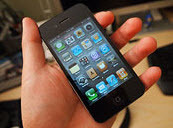Apple Says iPhone 4 Signal Problem Is Really Just About Bars

(drustar)
The iPhone 4 seems to have a problem with bars. First, the prototype for the Apple smartphone got left in one by a careless engineer, and now the new iPhone apparently has trouble displaying an appropriate number of bars to accurately depict its signal strength. Maybe the phone and the engineers need to find other places to hang out.
According to Apple, recent reports of a “death grip” that cut into the iPhone 4’s signal strength are overblown, and the real culprit is a software bug that displays the network level inaccurately:
To start with, gripping almost any mobile phone in certain ways will reduce its reception by 1 or more bars. This is true of iPhone 4, iPhone 3GS, as well as many Droid, Nokia and RIM phones. But some users have reported that iPhone 4 can drop 4 or 5 bars when tightly held in a way which covers the black strip in the lower left corner of the metal band. This is a far bigger drop than normal, and as a result some have accused the iPhone 4 of having a faulty antenna design. …
We have discovered the cause of this dramatic drop in bars, and it is both simple and surprising.
Upon investigation, we were stunned to find that the formula we use to calculate how many bars of signal strength to display is totally wrong. Our formula, in many instances, mistakenly displays 2 more bars than it should for a given signal strength. For example, we sometimes display 4 bars when we should be displaying as few as 2 bars. Users observing a drop of several bars when they grip their iPhone in a certain way are most likely in an area with very weak signal strength, but they don’t know it because we are erroneously displaying 4 or 5 bars. Their big drop in bars is because their high bars were never real in the first place.
Apple says it is working on a software upgrade that will fix the problem, and insists that the iPhone 4’s wireless performance “is the best we have ever shipped.”
According to AnandTech, which conducted tests on the iPhone 4’s signal strength, the model “gets the best cellular reception yet.” The site points out that its tests show that there are some reception problems based on hand position, and that similar problems exist with other phones:
“The fact of the matter is that cupping the bottom left corner and making skin contact between the two antennas does result in a measurable difference in cellular reception….
…Inside a case, the iPhone 4 performs slightly better than the Nexus One. However, attenuation gets measurably worse depending how you hold the phone. Squeezing it really tightly, you can drop as much as 24 dB. Holding it naturally, I measured an average drop of 20 dB.
The drop in signal from cupping the device with a case on is purely a function of us being “ugly bags of mostly water.” A material which happens to be pretty good at attenuating RF – thus increasing path loss between the handset and cellular base station. There’s nothing Apple nor anyone else can do to get around physics, plain and simple. It’s something which demonstrably affects every phone’s cellular reception.
… [E]ither the most sensitive region of the antenna should have an insulative coating, or everyone should use a case.”
Confused? Maybe it’s time to hit those “4 or 5 bars” Apple refers to, and stay there until you get a clear answer.
Letter from Apple Regarding iPhone 4 [Apple.com]
The Real Story on iPhone 4’s Antenna [AnandTech]
Want more consumer news? Visit our parent organization, Consumer Reports, for the latest on scams, recalls, and other consumer issues.

